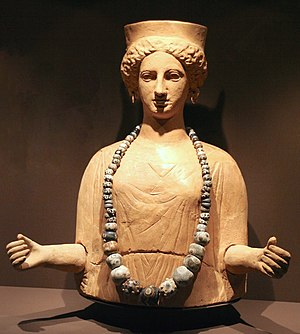
Back آلهة قرطاج Arabic Relixón en Cartago AST Религия на Картаген Bulgarian Karthagische Religion German Religión en Cartago Spanish Religion punique French Agama di Kartago ID Religione cartaginese Italian Religie in Carthago Dutch Религия Карфагена Russian

The Punic religion, Carthaginian religion, or Western Phoenician religion in the western Mediterranean was a direct continuation of the Phoenician variety of the polytheistic ancient Canaanite religion. However, significant local differences developed over the centuries following the foundation of Carthage and other Punic communities elsewhere in North Africa, southern Spain, Sardinia, western Sicily, and Malta from the ninth century BC onward. After the conquest of these regions by the Roman Republic in the third and second centuries BC, Punic religious practices continued, surviving until the fourth century AD in some cases. As with most cultures of the ancient Mediterranean, Punic religion suffused their society and there was no stark distinction between religious and secular spheres.[1] Sources on Punic religion are poor. There are no surviving literary sources and Punic religion is primarily reconstructed from inscriptions and archaeological evidence.[2] An important sacred space in Punic religion appears to have been the large open air sanctuaries known as tophets in modern scholarship, in which urns containing the cremated bones of infants and animals were buried. There is a long-running scholarly debate about whether child sacrifice occurred at these locations, as suggested by Greco-Roman and biblical sources.
- ^ Xella 2019, p. 273.
- ^ Xella 2019, p. 273, 281.
© MMXXIII Rich X Search. We shall prevail. All rights reserved. Rich X Search